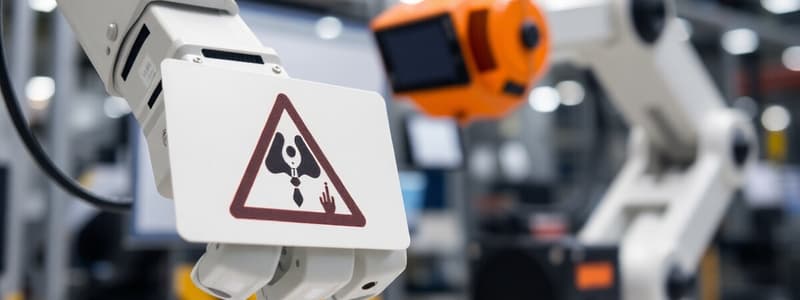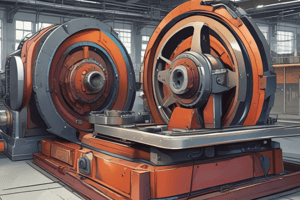Podcast
Questions and Answers
What does the variable S represent in the stopping distance formula S = V2/30 μ?
What does the variable S represent in the stopping distance formula S = V2/30 μ?
- Stopping distance (correct)
- Coefficient of friction
- Time taken to stop
- Initial velocity
What does a presence-sensing mat do?
What does a presence-sensing mat do?
- Alerts operators about hazardous areas
- Detects operator presence to start the machine
- Detects a predetermined weight to stop machine operation (correct)
- Automatically adjusts to the height of the operator
Which of the following is a common hazard associated with railroads?
Which of the following is a common hazard associated with railroads?
- Wind shear
- Poor communication
- Grade crossing accidents (correct)
- Icing of wings
What is a limitation of enclosure guards in machinery?
What is a limitation of enclosure guards in machinery?
What is the primary function of two-hand control systems?
What is the primary function of two-hand control systems?
What is one of the critical components of hazard control?
What is one of the critical components of hazard control?
Which type of gate provides a barrier during the entire machine cycle?
Which type of gate provides a barrier during the entire machine cycle?
What is a pinch point hazard?
What is a pinch point hazard?
What is a disadvantage of adjustable guards?
What is a disadvantage of adjustable guards?
What is the role of pullback devices in machine safety?
What is the role of pullback devices in machine safety?
What additional precautions are needed when entering the robotics work envelope?
What additional precautions are needed when entering the robotics work envelope?
How does pendant control benefit robot operation?
How does pendant control benefit robot operation?
What is the purpose of locking out main power sources on machines or systems?
What is the purpose of locking out main power sources on machines or systems?
What does a presence-sensing device do?
What does a presence-sensing device do?
Which type of gate provides a barrier during the downstroke of a mechanical press?
Which type of gate provides a barrier during the downstroke of a mechanical press?
What is a feature of self-adjusting guards?
What is a feature of self-adjusting guards?
What is the main function of restraint devices?
What is the main function of restraint devices?
What does the two-hand control safeguard require?
What does the two-hand control safeguard require?
What is the main purpose of awareness barriers?
What is the main purpose of awareness barriers?
Which of the following describes adjustable guards?
Which of the following describes adjustable guards?
How do pullback devices function?
How do pullback devices function?
What is one of the key components of hazard control?
What is one of the key components of hazard control?
Which of the following is an example of a design error that can introduce hazards?
Which of the following is an example of a design error that can introduce hazards?
What can result from inadequate packaging in production and distribution?
What can result from inadequate packaging in production and distribution?
Which principle is crucial for minimizing hazards?
Which principle is crucial for minimizing hazards?
What is the highest priority for reducing hazards?
What is the highest priority for reducing hazards?
What can lead to failures and hazards in hazard control planning and design?
What can lead to failures and hazards in hazard control planning and design?
How can hazard severity be reduced?
How can hazard severity be reduced?
What should be prioritized first when reducing hazards?
What should be prioritized first when reducing hazards?
What does redundancy in a system help to achieve?
What does redundancy in a system help to achieve?
Which category is associated with locations where flammable gases are present?
Which category is associated with locations where flammable gases are present?
Which component is NOT part of the communication process that can introduce hazards?
Which component is NOT part of the communication process that can introduce hazards?
What is a recommended measure to minimize the likelihood of exposure to hazards?
What is a recommended measure to minimize the likelihood of exposure to hazards?
What can defective or damaged cords lead to?
What can defective or damaged cords lead to?
Which of the following is an example of a hazardous location?
Which of the following is an example of a hazardous location?
What is the primary objective of hazard control?
What is the primary objective of hazard control?
How can redundancy in a system help in hazard control?
How can redundancy in a system help in hazard control?
Which of the following actions is effective in preventing electrical hazards?
Which of the following actions is effective in preventing electrical hazards?
What is NOT a principle of hazard control?
What is NOT a principle of hazard control?
What factor is critical in ensuring effective hazard communication?
What factor is critical in ensuring effective hazard communication?
Which of these is an inappropriate safety practice regarding electrical cords?
Which of these is an inappropriate safety practice regarding electrical cords?
Flashcards
Presence-sensing Mat
Presence-sensing Mat
A safety device that stops a machine when a specific weight is detected on the mat.
Two-hand Control
Two-hand Control
Requires both hands to be actively engaged to start the machine cycle, preventing hands from entering the danger zone.
Type 'A' Gate
Type 'A' Gate
A safety barrier that moves to block the operator's access to the danger zone during machine operation.
Type 'B' Gate
Type 'B' Gate
Signup and view all the flashcards
Awareness Barrier
Awareness Barrier
Signup and view all the flashcards
Hood Guard
Hood Guard
Signup and view all the flashcards
Restraint Device
Restraint Device
Signup and view all the flashcards
Zero Mechanical State (ZMS)
Zero Mechanical State (ZMS)
Signup and view all the flashcards
Presence-sensing Devices
Presence-sensing Devices
Signup and view all the flashcards
Pullback Devices
Pullback Devices
Signup and view all the flashcards
Stopping Distance Formula
Stopping Distance Formula
Signup and view all the flashcards
Pinch Point Hazard
Pinch Point Hazard
Signup and view all the flashcards
Enclosure Guard
Enclosure Guard
Signup and view all the flashcards
Hazard
Hazard
Signup and view all the flashcards
Hazard Control
Hazard Control
Signup and view all the flashcards
Design Error
Design Error
Signup and view all the flashcards
Hazardous Locations
Hazardous Locations
Signup and view all the flashcards
Reducing Probability of Occurrence
Reducing Probability of Occurrence
Signup and view all the flashcards
Reducing Hazard Severity
Reducing Hazard Severity
Signup and view all the flashcards
Redundancy
Redundancy
Signup and view all the flashcards
Preventive Actions
Preventive Actions
Signup and view all the flashcards
Corrective Actions
Corrective Actions
Signup and view all the flashcards
Effective Communication
Effective Communication
Signup and view all the flashcards
Hazard Reduction Priorities
Hazard Reduction Priorities
Signup and view all the flashcards
Design Errors and Hazards
Design Errors and Hazards
Signup and view all the flashcards
Production and Distribution Hazards
Production and Distribution Hazards
Signup and view all the flashcards
Communication and Hazards
Communication and Hazards
Signup and view all the flashcards
Redundancy for Safety
Redundancy for Safety
Signup and view all the flashcards
Hazardous Location Classifications
Hazardous Location Classifications
Signup and view all the flashcards
Safety with Cords
Safety with Cords
Signup and view all the flashcards
Historical Data and Hazard Identification
Historical Data and Hazard Identification
Signup and view all the flashcards
Communication Components
Communication Components
Signup and view all the flashcards
Study Notes
Hazard Control
- Hazard control involves reducing or eliminating risks from hazards.
- Planning and design are crucial for hazard control, crucial for preventing failures and hazards
- Failure to consider the environment, use of incorrect factors of safety, and inadequate assumptions, can all introduce hazards.
Production and Distribution
- Hazards can arise during production and distribution stages, like replacing chemicals or using inadequate packaging.
- Poor maintenance and repair increase hazards in these processes
Communication
- Poor communication introduces hazards, especially when changes are not communicated effectively.
- The four components that make up communication are: sender, message, channel, and receiver
Principles of Hazard Control
- To minimize hazards, recognize them, define preventive actions, assign responsibility, and measure effectiveness.
- Historical data helps identify potential hazards
Reduce the Hazard
- Priorities for hazard reduction include eliminating, reducing hazard level, utilizing safety devices, warnings, and safety procedures.
- Reducing severity leads to less injury.
- Strategies for reducing severity include placing hazards in low-traffic areas, using smaller amounts of hazardous materials
Redundancy-Backup System
- Backup systems, or redundancy, in an operation or system lowers the probability of component failure.
Hazardous Locations
- Locations are classified into three categories:
- Class I: Flammable/explosive mixtures
- Class II: Combustible dust
- Class III: Easily ignitable fibers/flyings.
Defective or Damaged Cords
- Improperly used cords cause shocks, burns, fires
- Safety measures include insulating live wires, inspecting cords before use, and only using 3-wire cords for heavy use
Accident Reconstruction
- S = V2⁄30μ where S is stopping distance, V is initial velocity, and μ is coefficient of friction.
Railroads
- Explosions, fires, and releases of toxic materials are common hazards, usually from grade crossings.
Aviation Hazards
- Leaking fuel tanks and ignition, icing of wings, and detecting wind shear are significant concerns.
Pinch Point Hazards
- Hazards occur when two or more objects move towards one another crushing or shearing whatever is between them
Enclosure Guards
- Fixed guards prevent additional hazards, like pinch points, and allow viewing points of operation
- Guards may be impractical for changing productions, repair or adjustment.
Distance and Location
- Minimum distance from floor/surface to mechanical power transmission apparatus varies, commonly 7 to 8 ft.
Studying That Suits You
Use AI to generate personalized quizzes and flashcards to suit your learning preferences.




